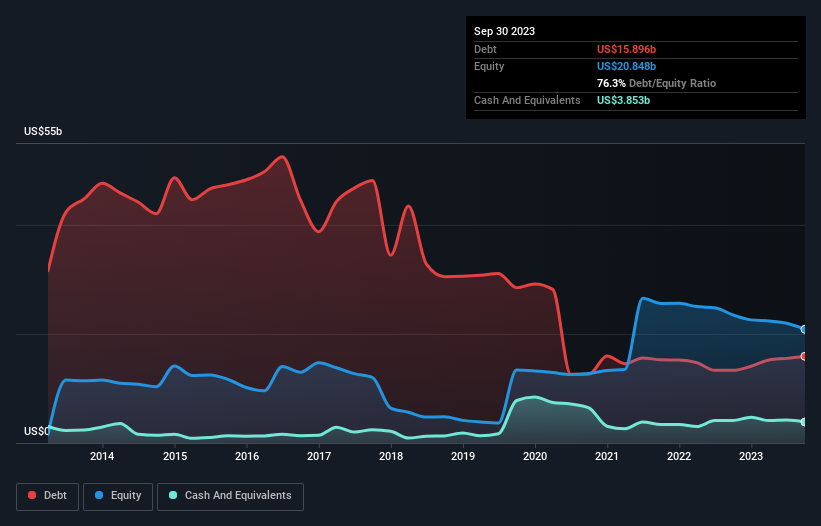- United States
- /
- Telecom Services and Carriers
- /
- NasdaqGS:LBTY.A
Is Liberty Global (NASDAQ:LBTY.A) Using Debt In A Risky Way?
The external fund manager backed by Berkshire Hathaway's Charlie Munger, Li Lu, makes no bones about it when he says 'The biggest investment risk is not the volatility of prices, but whether you will suffer a permanent loss of capital.' So it might be obvious that you need to consider debt, when you think about how risky any given stock is, because too much debt can sink a company. Importantly, Liberty Global Ltd. (NASDAQ:LBTY.A) does carry debt. But the more important question is: how much risk is that debt creating?
Why Does Debt Bring Risk?
Debt is a tool to help businesses grow, but if a business is incapable of paying off its lenders, then it exists at their mercy. In the worst case scenario, a company can go bankrupt if it cannot pay its creditors. While that is not too common, we often do see indebted companies permanently diluting shareholders because lenders force them to raise capital at a distressed price. Of course, plenty of companies use debt to fund growth, without any negative consequences. The first thing to do when considering how much debt a business uses is to look at its cash and debt together.
See our latest analysis for Liberty Global
What Is Liberty Global's Net Debt?
The image below, which you can click on for greater detail, shows that at September 2023 Liberty Global had debt of US$15.9b, up from US$13.3b in one year. However, it does have US$3.85b in cash offsetting this, leading to net debt of about US$12.0b.

How Healthy Is Liberty Global's Balance Sheet?
The latest balance sheet data shows that Liberty Global had liabilities of US$3.73b due within a year, and liabilities of US$18.1b falling due after that. Offsetting this, it had US$3.85b in cash and US$889.3m in receivables that were due within 12 months. So it has liabilities totalling US$17.1b more than its cash and near-term receivables, combined.
This deficit casts a shadow over the US$7.68b company, like a colossus towering over mere mortals. So we'd watch its balance sheet closely, without a doubt. At the end of the day, Liberty Global would probably need a major re-capitalization if its creditors were to demand repayment. When analysing debt levels, the balance sheet is the obvious place to start. But it is future earnings, more than anything, that will determine Liberty Global's ability to maintain a healthy balance sheet going forward. So if you want to see what the professionals think, you might find this free report on analyst profit forecasts to be interesting.
Over 12 months, Liberty Global saw its revenue hold pretty steady, and it did not report positive earnings before interest and tax. While that's not too bad, we'd prefer see growth.
Caveat Emptor
Over the last twelve months Liberty Global produced an earnings before interest and tax (EBIT) loss. To be specific the EBIT loss came in at US$119m. When we look at that alongside the significant liabilities, we're not particularly confident about the company. We'd want to see some strong near-term improvements before getting too interested in the stock. For example, we would not want to see a repeat of last year's loss of US$5.3b. And until that time we think this is a risky stock. The balance sheet is clearly the area to focus on when you are analysing debt. However, not all investment risk resides within the balance sheet - far from it. For instance, we've identified 2 warning signs for Liberty Global (1 is potentially serious) you should be aware of.
At the end of the day, it's often better to focus on companies that are free from net debt. You can access our special list of such companies (all with a track record of profit growth). It's free.
New: AI Stock Screener & Alerts
Our new AI Stock Screener scans the market every day to uncover opportunities.
• Dividend Powerhouses (3%+ Yield)
• Undervalued Small Caps with Insider Buying
• High growth Tech and AI Companies
Or build your own from over 50 metrics.
Have feedback on this article? Concerned about the content? Get in touch with us directly. Alternatively, email editorial-team (at) simplywallst.com.
This article by Simply Wall St is general in nature. We provide commentary based on historical data and analyst forecasts only using an unbiased methodology and our articles are not intended to be financial advice. It does not constitute a recommendation to buy or sell any stock, and does not take account of your objectives, or your financial situation. We aim to bring you long-term focused analysis driven by fundamental data. Note that our analysis may not factor in the latest price-sensitive company announcements or qualitative material. Simply Wall St has no position in any stocks mentioned.
About NasdaqGS:LBTY.A
Liberty Global
Provides broadband internet, video, fixed-line telephony, and mobile communications services to residential and business customers.
Undervalued with imperfect balance sheet.
Similar Companies
Market Insights
Community Narratives





